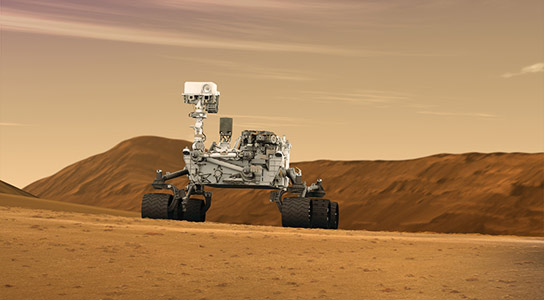
A new study from UC Irvine shows that galactic cosmic rays can cause dementia-like symptoms, making extended space trips to locations such as Mars more difficult to accomplish.
What happens to an astronaut’s brain during a mission to Mars? Nothing good. It’s besieged by destructive particles that can forever impair cognition, according to a UC Irvine radiation oncology study appearing in the May 1 edition of Science Advances.
Charles Limoli and colleagues found that exposure to highly energetic charged particles — much like those found in the galactic cosmic rays that bombard astronauts during extended spaceflights — cause significant damage to the central nervous system, resulting in cognitive impairments.
“This is not positive news for astronauts deployed on a two- to three-year round trip to Mars,” said Limoli, a professor of radiation oncology in UCI’s School of Medicine. “Performance decrements, memory deficits, and loss of awareness and focus during spaceflight may affect mission-critical activities, and exposure to these particles may have long-term adverse consequences to cognition throughout life.”
For the study, rodents were subjected to charged particle irradiation (fully ionized oxygen and titanium) at the NASA Space Radiation Laboratory at the Brookhaven National Laboratory before being sent back to Limoli’s Irvine lab.
The researchers found that exposure to these particles resulted in brain inflammation, which disrupted the transmission of signals among neurons. Imaging revealed how the brain’s communication network was impaired through reductions in the structure of nerve cells called dendrites and spines. Additional synaptic alterations in combination with the structural changes interfered with the capability of nerve cells to efficiently transmit electrochemical signals. Furthermore, these differences were parallel to decreased performance on behavioral tasks designed to test learning and memory.
Similar types of more severe cognitive dysfunction are common in brain cancer patients who have received various photon-based radiation treatments at much higher doses. In other research, Limoli studies the impact of chemotherapy and cranial irradiation on cognition.
While cognitive deficits in astronauts would take months to manifest, Limoli said, the time required for a mission to Mars is sufficient for such deficits to develop. People working for extended periods on the International Space Station do not face the same level of bombardment with galactic cosmic rays, as they are still within the protective magnetosphere of the Earth.
The irradiated particles that compose these galactic cosmic rays are mainly remnants of past supernova events.
Limoli’s work is part of NASA’s Human Research Program. Investigating how space radiation affects astronauts and learning ways to mitigate those effects are critical to further human exploration of space, and NASA needs to consider these risks as it plans for missions to Mars and beyond.
But what can be done to protect astronauts speeding off to the red planet?
As a partial solution, Limoli said, spacecraft could be designed to include areas of increased shielding, such as those used for rest and sleep. However, these highly energetic particles will traverse the ship nonetheless, he noted, “and there is really no escaping them.”
Preventative treatments offer some hope. “We are working on pharmacologic strategies involving compounds that scavenge free radicals and protect neurotransmission,” Limoli said. “But these remain to be optimized and are under development.”
Reference: “What happens to your brain on the way to Mars” by Pvipan K. Parihar, Barrett Allen, Katherine K. Tran, Trisha G. Macaraeg, Esther M. Chu, Stephanie F. Kwok, Nicole N. Chmielewski, Brianna M. Craver, Janet E. Baulch, Munjal M. Acharya, Francis A. Cucinotta and Charles L. Limoli, 1 May 2015, Science Advances.
DOI: 10.1126/sciadv.1400256
Never miss a breakthrough: Join the SciTechDaily newsletter.